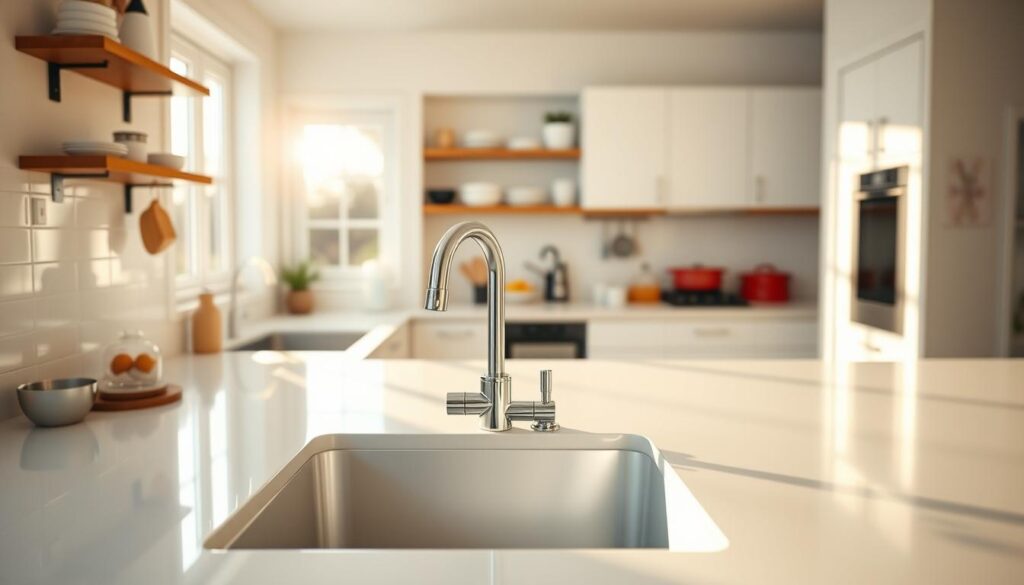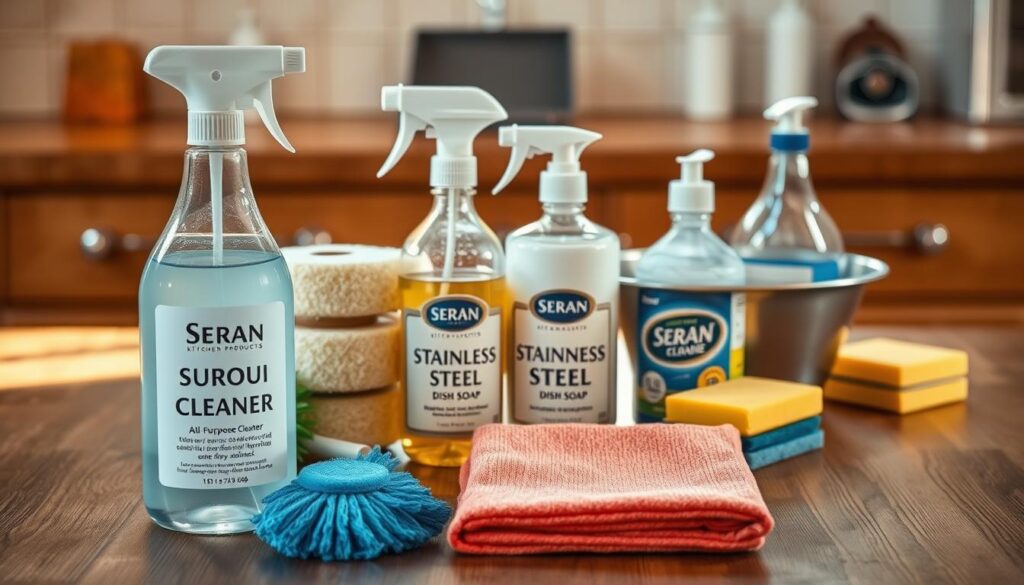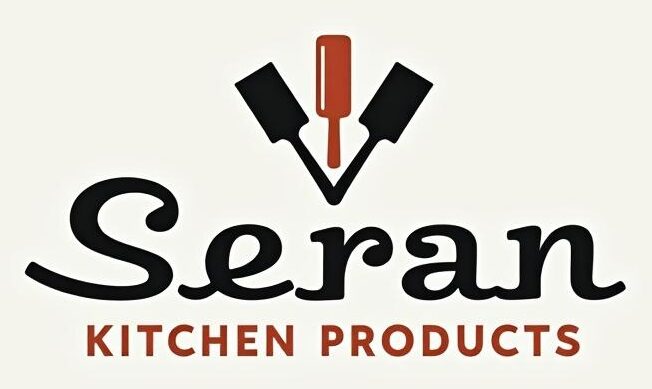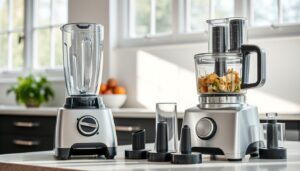Did you know that 80% of foodborne illnesses come from dirty kitchens? This fact shows how critical it is to keep your kitchen clean. Learning to deep clean your kitchen is not just a nice thing to do. It’s essential for a safe and healthy place to cook.
This guide will walk you through a detailed cleaning process. You’ll make sure every part of your kitchen is clean. Our checklist will help you make your kitchen shine and be safe.
Starting this deep cleaning journey means being consistent. Remember, a clean kitchen is not just pretty. It’s also key to your family’s health.
Key Takeaways
- Regular deep cleaning reduces the risk of foodborne illnesses.
- A systematic checklist ensures no area is overlooked.
- Maintaining cleanliness promotes a positive cooking environment.
- Eco-friendly cleaning products can be highly effective.
- Establishing a routine simplifies ongoing kitchen maintenance.
Understanding the Importance of a Deep Clean
A deep clean is key for your kitchen’s looks and function. It keeps your food space safe and healthy. A clean kitchen makes cooking better and safer for everyone.
Keeping your kitchen tidy and clean boosts your cooking skills. It makes meal prep more fun and efficient.
Benefits of a Clean Kitchen Environment
A clean kitchen feels welcoming and makes cooking more enjoyable. It’s easier to find what you need when everything is tidy. Clean counters and organized cabinets help you cook smoothly.
Cleaning your kitchen sparks creativity in cooking. It makes cooking for others more fun and rewarding.
Health Implications of Kitchen Hygiene
Good kitchen hygiene stops health problems from food. Dirty kitchens can spread harmful bacteria, causing sickness. Keeping your kitchen clean protects your health and makes you feel confident in your cooking.
Knowing the risks and cleaning regularly helps avoid health issues. It’s important for a safe and healthy kitchen.

Gathering Your Supplies for the Deep Cleaning Process
Before you start cleaning your kitchen, it’s important to gather the right tools and products. Having a good supply list makes the cleaning easier and faster. It’s also key to know about both traditional and eco-friendly cleaning options. This way, you can clean effectively while staying true to your values.
Essential Cleaning Supplies
Having the right tools makes cleaning better. Here are some must-haves:
- Sponges: Great for scrubbing without scratching.
- Microfiber cloths: Good for dusting and polishing.
- Scrub brushes: Needed for tough stains and grime.
- All-purpose cleaner: Versatile for many surfaces.
- Glass cleaner: Keeps windows and surfaces streak-free.
- Disinfectant spray: Important for sanitizing high-touch areas.
Eco-Friendly Cleaning Options
Choosing eco-friendly options is good for the planet and your indoor air. Here are some great alternatives:
- Baking soda: Natural for deodorizing and cleaning.
- White vinegar: Good for cutting grease and disinfecting.
- Lemon juice: Removes stains and adds a fresh scent.
- Castile soap: Plant-based for many surfaces.
- Essential oils: Natural fragrances with antibacterial properties.

Using these supplies and options will make your kitchen clean and healthy. With your tools ready, you can start your deep cleaning with confidence.
How to Deep Clean Your Kitchen: A Step-by-Step Checklist
Deep cleaning your kitchen needs a plan. Use a kitchen cleaning checklist to guide you. This way, you can clean each area well. Make a cleaning schedule to fit cleaning into your daily life.
Prioritizing Your Deep Cleaning Tasks
Know which areas need the most cleaning. Start with high-traffic spots like countertops and sinks. Then, clean appliances like the fridge and oven, which get dirty fast. Here are some tasks for your cleaning guide:
- Declutter and clear countertops.
- Wipe down surfaces, focusing on spots that accumulate dirt quickly.
- Deep clean appliances, starting with those that are used most frequently.
- Address floor cleaning last, as it will capture any debris that falls during the process.
Creating a Cleaning Schedule
Keeping your kitchen clean needs regular effort. Make a cleaning schedule that fits your life. Divide deep cleaning tasks into the week to avoid feeling overwhelmed. Here are some tasks to include:
- Daily: Tidy countertops and wash dishes.
- Weekly: Wipe down appliances and clean floors.
- Monthly: Deep clean cabinets and drawers.
- Seasonally: Conduct a thorough refrigerator clean-out.
Cleaning Appliances: The Heart of Your Kitchen
When cleaning your kitchen, don’t forget the appliances. They’re key for food prep and storage but can be breeding grounds for bacteria. Make sure to give the fridge, oven, stovetop, and small appliances a good cleaning.
How to Clean Your Refrigerator
Cleaning the fridge is a must for food safety. First, take out all food and check expiration dates. Discard anything past its date. Then, remove shelves and drawers and soak them in warm, soapy water.
While they soak, clean the fridge’s interior with baking soda and water. This mix fights off bad smells. Once everything is dry, put back the shelves and organize your food.
Deep Cleaning the Oven and Stovetop
Cleaning the oven and stovetop might look hard, but it’s essential. Start by removing any debris or burnt food from the oven. Use an oven cleaner or baking soda paste on the inside, letting it sit for hours.
For the stovetop, take off burners and knobs. Clean the surface with a good cleaner, focusing on tough stains. Rinse and dry well before putting everything back.
Cleaning the Microwave and Other Small Appliances
To clean the microwave, use a bowl of water with lemon wedges. Run it for a few minutes to loosen grime. Then, wipe the interior with a cloth.
Small appliances like toasters and blenders need a wipe down with a damp cloth. Unplug them first. Make sure to wash any removable parts separately for a deep clean.
Countertops and Surfaces: Ensuring Thorough Cleanliness
Keeping countertops and surfaces clean is key to a hygienic kitchen. Each material needs special care during deep cleaning. A detailed checklist helps choose the right cleaning products for each surface.
Choosing the Right Cleaning Products for Different Surfaces
Each countertop material needs its own cleaning solution. Here are some tips:
- Granite: Use a pH-balanced cleaner or warm water with dish soap. Stay away from acidic products that can dull the granite.
- Quartz: Soap and water are good. For tough stains, use a non-abrasive cleaner.
- Laminate: Vinegar and water mix is safe for laminate. Avoid abrasive sponges that can scratch.
Steps for Cleaning and Disinfecting Counters
Follow these steps to keep surfaces clean and extend their life:
- Clear the countertop of all items and debris.
- Dust the surface with a microfiber cloth to remove loose particles.
- Choose the right cleaner for your countertop material.
- Apply the cleaner and let it sit for the recommended time.
- Wipe down with a clean cloth, making sure no residue is left.
- Use a disinfectant for food surfaces, if needed.
Cabinets and Drawers: A Deeper Dive
Cleaning kitchen cabinets and drawers is key to a deep clean. These spots can get dusty and grimy, affecting your kitchen’s look and use. Organizing well makes cooking easier and keeps your kitchen tidy. Clean kitchen tips can make this task more efficient.
How to Organize While You Clean
Begin by emptying cabinets and drawers. This lets you see what you really use and what you can get rid of. As you organize, keep these tips in mind:
- Group similar items together, like baking stuff, utensils, and pots.
- Use dividers or containers to keep things tidy. This makes your kitchen look better.
- Label bins for easy access. This makes finding things easier later.
- Get rid of items you don’t use anymore. This keeps your space clutter-free.
Wiping Down Interior and Exterior Surfaces
After organizing, focus on cleaning surfaces. Choose a multi-surface cleaner that fits your cabinet type, like wood, laminate, or metal. Here’s how to clean effectively:
- Use a microfiber cloth with cleaner on it, not directly on surfaces. This avoids too much moisture.
- Clean the interior of cabinets first. Pay special attention to corners and edges where dust builds up.
- Then, clean the exterior surfaces. Make sure to remove fingerprints and stains for a shiny look.
- Finish with a dry cloth to wipe away any cleaner residue.
By following these clean kitchen tips, you’ll have a spotless kitchen. This makes cooking more fun and keeps your home healthy. A clean kitchen is not just about looks; it’s also about enjoying cooking.
Floor Cleaning: Getting Rid of Stubborn Grime
Clean floors are key to a tidy kitchen. Dirt, grease, and stains can build up, so regular cleaning is a must. Each floor type needs its own cleaning method to stay in good shape.
Types of Kitchen Flooring and Cleaning Methods
Knowing your kitchen floor can help you clean it right. Here’s a look at common floors and how to clean them:
| Floor Type | Cleaning Method | Best Kitchen Cleaning Practices |
|---|---|---|
| Tile | Use a mixture of warm water and mild detergent. Scrub with a soft brush to remove grime. | Regular sweeping prevents dirt from scratching tiles. Mop frequently to keep grout lines clean. |
| Hardwood | Use a damp mop with a gentle cleaning solution for hardwood. | Avoid too much water. Dry spills fast and sweep often to avoid damage. |
| Vinyl | Wash with warm soapy water and a soft mop. Avoid harsh cleaners. | Regular sweeping or vacuuming helps prevent scratches. Use a damp mop for deeper cleans. |
Best Practices for Mopping and Sweeping
Keeping up with mopping and sweeping is vital for clean floors. Here are some tips:
- Always sweep or vacuum before mopping to remove loose debris.
- Use a clean mop and change water often to avoid spreading dirt.
- For tough stains, let the cleaner sit for a few minutes before scrubbing.
- Plan regular deep cleaning to tackle deep grime.
Final Touches: Ensuring a Tidy Finish
After a deep clean, do a final check. This is key to catch any spots missed. Look closely at spots like behind appliances and under cabinets. This way, you’ll get your kitchen as clean as you want.
Inspecting Your Work for Missed Spots
Focus on these areas when you inspect:
- Countertops and cutting boards
- Appliance surfaces, including the refrigerator and microwave
- Cabinet fronts and handles
- Sink area
- Floors for any stubborn stains
Use a checklist to mark off each area as you clean. This ensures your kitchen stays clean. These tips will keep your kitchen spotless.
Setting Up a Maintenance Routine
After cleaning, set up a routine to keep it clean. Add simple daily tasks to your routine:
- Wipe down surfaces after cooking
- Wash dishes right after use
- Vacuum or sweep the floor every day
- Empty and clean the trash often
- Organize pantry and fridge weekly
Sticking to this routine makes future deep cleans easier. Regular cleaning keeps your kitchen safe and pleasant for cooking.
Kitchen Sanitation Tips for Daily Maintenance
Keeping your kitchen clean doesn’t take a lot of time or effort. By adding quick cleaning habits to your daily routine, you can keep your kitchen safe and clean. Small actions can greatly reduce dirt and bacteria, making your kitchen a healthier place to cook.
Incorporating Quick Cleaning Habits
Creating a routine of quick cleaning habits can make your kitchen much cleaner. Here are a few easy strategies to try:
- Wipe down countertops right after you’re done cooking.
- Rinse dishes as soon as you’re done using them to avoid tough stains.
- Sweep the floor every day to get rid of crumbs and dirt.
- Take a few minutes each night to organize your kitchen tools and utensils.
- Empty the trash every day to stop odors and pests.
Tools to Keep Your Kitchen Clean
Using the right tools makes keeping your kitchen clean easier. Here are some essential cleaning tools:
| Tool | Description |
|---|---|
| Microfiber Cloths | Perfect for cleaning surfaces without leaving lint or scratches. |
| Sponge & Scrubber | Great for removing tough stains from dishes and surfaces. |
| Broom and Dustpan | Important for keeping floors clean of debris. |
| All-Purpose Cleaner | Works well on different surfaces and cuts through grease. |
| Trash Bags | Use strong bags to keep trash in and control odors. |
Conclusion
As we wrap up this guide on deep cleaning your kitchen, remember how important a clean space is. It’s not just about looks; it’s about keeping food safe and healthy. By following our checklist, you’re making your kitchen a better place to cook.
Deep cleaning your kitchen might seem hard at first. But, breaking it down into smaller tasks makes it easier. Cleaning appliances, countertops, and floors are all key to a clean kitchen. This routine makes cooking more efficient and enjoyable.
Now, it’s time to start cleaning your kitchen. Make cleaning a part of your daily routine. A clean kitchen makes cooking better and improves your home’s feel. Begin today and see the difference a clean kitchen makes.
FAQ
What is the best way to start deep cleaning my kitchen?
Start by making a detailed cleaning checklist. First, gather all your cleaning supplies. Then, clean one area at a time, like countertops, appliances, or floors. This makes the task easier to handle.
How often should I deep clean my kitchen?
Deep clean your kitchen at least once a season. But, if you cook a lot or have a busy kitchen, do it every month. This keeps your kitchen clean and safe.
What are some kitchen cleaning tips for maintaining hygiene daily?
To keep your kitchen clean daily, adopt quick cleaning habits. Wipe down surfaces after use and wash dishes right away. Also, check for expired items regularly. A kitchen sanitation checklist can help you stay on track.
Are there eco-friendly options for kitchen deep cleaning?
Yes! Use natural cleaners like vinegar, baking soda, and lemon juice. They are effective and safe for the environment. These products help you clean your kitchen without harsh chemicals.
How do I clean kitchen appliances properly?
Focus on cleaning the refrigerator, oven, and stovetop first. Use the right cleaner for each appliance. Follow a deep cleaning kitchen checklist to make sure you don’t miss any spots.
What surfaces should I pay extra attention to when cleaning my kitchen?
Give extra care to countertops, cabinet faces, and floors. These areas collect dirt, grime, and bacteria. Use the right cleaning products for each surface to keep them looking good and lasting longer.
How can I keep my kitchen organized while deep cleaning?
Use the cleaning time to declutter and organize your cabinets and drawers. Sort items by type and get rid of what you don’t need. This makes your kitchen more functional and keeps it tidy.
What are some effective methods for floor cleaning in the kitchen?
For floor cleaning, start by sweeping or vacuuming. Then, mop with a cleaner that matches your floor type. Make sure to rinse your mop often to remove tough dirt.


